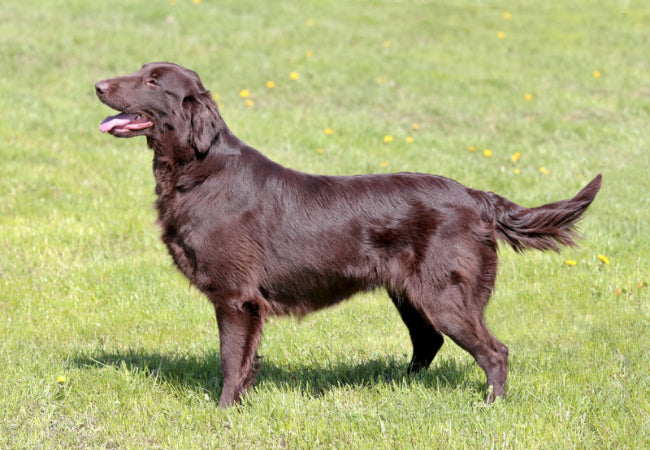Flat-Coated Retriever 2025 Guide: Temperament, Care & Training 🐶

In this article
Flat-Coated Retriever 2025 Guide: Temperament, Care & Training 🐶
By Dr. Duncan Houston BVSc
The Flat-Coated Retriever is an energetic, fun-loving, and affectionate sporting breed known for its shiny black or liver coat and perpetual puppy-like spirit. These dogs are versatile hunters, loyal companions, and famously cheerful family members. In this detailed 2025 vet-authored guide, we’ll explore how to raise, train, and care for a healthy, happy Flat-Coated Retriever. 🐾
📜 Breed Origins
Developed in 19th-century England, the Flat-Coated Retriever was bred for retrieving game from land and water. Ancestors include the Newfoundland, Setter, and St. John’s water dog. Once more popular than the Labrador, Flat-Coats nearly vanished post-WWI but have made a strong comeback thanks to their personality and versatility. 🇬🇧
🧠 Temperament & Personality
These dogs are known for their boundless enthusiasm and people-loving nature:
- Playful: Always ready for a game of fetch or an outdoor adventure
- Affectionate: Love human attention and thrive in social settings
- Intelligent: Quick learners who enjoy working and training
- Clownish: Known for their sense of humor and puppyish demeanor
🏡 Ideal Home Environment
Flat-Coats need space, structure, and stimulation. Best fits include:
- Active families with room to play and exercise
- Homes with large fenced yards or near outdoor trails
- Households where the dog isn’t left alone for long hours
They are not ideal for sedentary homes or confined living without daily activity. 🏡
✂️ Coat Type & Grooming
Flat-Coats have a long, shiny, waterproof coat that needs regular attention:
- Brushing: 2–3 times per week to prevent mats and control shedding
- Bathing: Every 4–6 weeks or after swimming
- Ear Cleaning: Weekly—especially after water exposure
- Nail Trimming: Monthly or as needed
🏃♂️ Exercise & Mental Enrichment
This is a high-energy breed with high exercise and engagement needs:
- 90 minutes of activity daily (walks, swimming, fetch, running)
- Field work, agility, or advanced obedience training
- Interactive toys, food puzzles, and hide-and-seek games
Without enrichment, they may develop hyperactive or destructive behaviors. 🧠
🍗 Nutrition & Feeding
Feed a balanced, performance-oriented diet to maintain muscle, coat, and stamina:
- High-quality proteins (chicken, fish, turkey)
- Omega-3s for skin, joints, and brain support
- Joint supplements if regularly hunting or running
Feed twice daily. For a personalized plan, visit Ask A Vet. 🍽️
🩺 Common Health Concerns
Flat-Coated Retrievers are generally healthy but prone to:
- Cancer (especially histiocytic sarcoma): A known breed risk—regular vet checkups are critical
- Hip & Elbow Dysplasia: Common in active breeds—screening advised
- Bloat (GDV): Feed in smaller meals and avoid exercise after eating
Preventive care and screening are key—consult Ask A Vet for ongoing support. 🩺
🎓 Training & Socialization
This breed is a joy to train when engaged properly:
- Begin obedience and socialization early
- Use positive reinforcement—praise, treats, and games
- Keep training fun to match their upbeat personality
🧘♂️ Emotional & Behavioral Needs
Flat-Coats are emotionally sensitive and thrive on attention:
- Daily affection and interaction are essential
- Use enrichment toys to prevent boredom during alone time
- Don’t leave them isolated—they’re social by nature
Need help with behavior or emotional health? Try Ask A Vet. 🧠
🏁 Final Thoughts: Is the Flat-Coated Retriever Right for You?
If you’re looking for a bright, bouncy, and lovable retriever with a zest for life and a knack for making you laugh, the Flat-Coated Retriever may be your perfect match. With proper grooming, exercise, and emotional support, this breed becomes an unforgettable companion. ❤️
Need help creating a care plan? Chat with a vet now at Ask A Vet!






